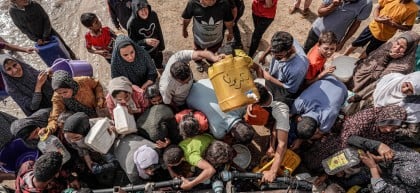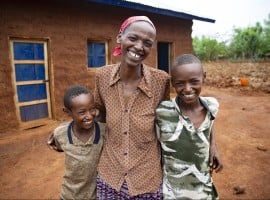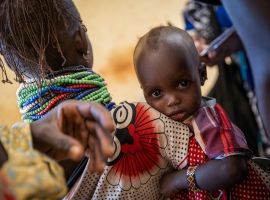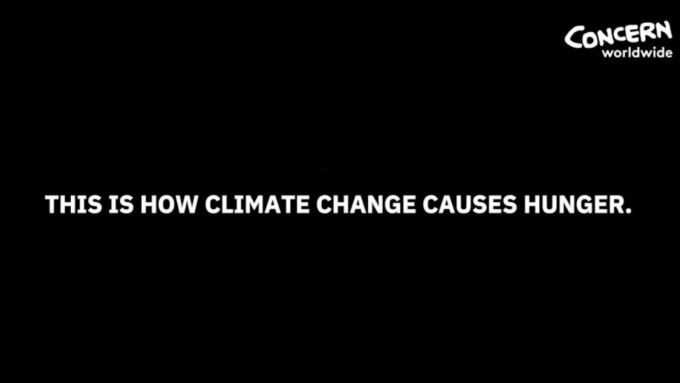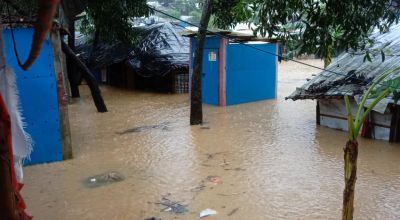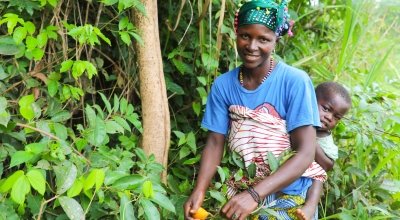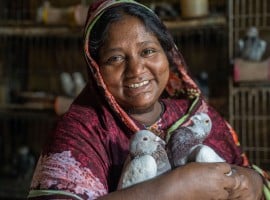
Read our 2024 annual report

Knowledge Hub
As 20,000 heads of state, diplomats, activists and lobbyists descend on Glasgow next week for the UN global warming conference, COP26, the lives of millions of people in some of the world’s poorest countries will hang in the balance.
While much of the public messaging around climate change has focused on future threats if we fail to take steps to prevent average global temperatures rising by more than 1.5 degrees Celsius, for millions of people in the world’s poorest countries, climate change is dramatically impacting their lives today and threatening their very existence.
From the two million Kenyans who are currently experiencing the latest in a series of increasingly frequent droughts, to the estimated 500,000 Bangladeshis annually forced by rising sea levels and flooding to leave their homes in low-lying coastal areas to move inland into over-crowded cities, the impact of climate change is very real and immediate today.
The climate crisis is a key driver of hunger in the world. Climate models project higher average temperatures in most land and ocean regions, hot extremes in the majority of inhabited regions, and heavy precipitation and an ever-greater probability of drought in some areas.
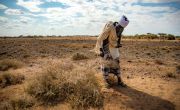
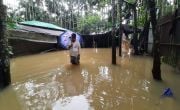

The implications of these projections are much greater in South Asia and Africa South of the Sahara—regions currently with high concentrations of poverty and hunger— where agriculture is highly dependent on rainfall and susceptible to even small changes in temperature.
Large populations (up to 80 percent of rural households in some countries) depend on agriculture for their livelihoods. Populations in these regions are most at risk of climate change–induced hunger and food insecurity.
The 2021 Global Hunger Index, published earlier this month, shows that hunger levels are significantly higher in countries that are most sensitive to rainfall and temperature extremes characteristic of climate change.
Unless urgent action is taken to help mitigate the impact of these changes and help communities adapt, the crisis will only get worse. A recent analysis showed that climate change could increase the number of chronically hungry people in 2050 by 78 million unless action is taken.
There is an urgent need for proper investment in climate mitigation and climate adaptation measures .and funding to address the losses and damages from climate impacts already being felt today. All eyes will be on global leaders at COP26 to see if they deliver on the key issue of climate finance and then subsequently deliver on commitments made.
Delivery will be key. In 2009, high-income countries made a commitment to allocate $100 billion annually by 2020 to help developing countries address the impacts of climate change. However, this commitment has never been met.
An analysis by the Zurich Flood Resilience Alliance in 2020 found that, not only was there insufficient investment provided to enable lower income countries prepare for the impacts of climate change, but funding that was provided was not going to the countries and people that need it most.
Their report found that climate vulnerable countries are not receiving preferential targeting from donors. Only a quarter of bilateral financing and less than half of the major multilateral financing has targeted the most climate vulnerable countries with climate change adaptation funding from 2010–2017. The majority of the most climate vulnerable countries received less than $20 per person per year in climate change adaptation financing from 2010–2017.
By 2030, climate change adaptation costs are expected to range between $140 billion and $300 billion a year, and rise to between $280 billion and $500 billion per year by 2050. For more severe scenarios of global warming these figures are expected to be much greater.
The longer adaptation and risk reduction efforts are put off by chronic underfunding in climate change adaptation and disaster risk reduction, the more difficult and expensive it will be to manage adaptation needs and the harder it will be to save lives and mitigate suffering.
Concern’s work on the ground with communities struggling to survive as climate change worsens the challenges they face involves a range of adaptation, resilience building and disaster risk management projects. From the construction of underground water tanks to harvest rain water, to the introduction of more drought-resistant plants and animals, and the construction of flood protection, these measures are enabling communities to adapt.
Inequality is at the heart of this issue. Many of the countries that have contributed least to the climate crisis are currently paying the highest price and that price is set to rise in the coming years.
They also do not have the financial resources to address the issue and protect their populations.
Their needs and the issue of climate justice must be top of the priority list of global leaders when they gather in Glasgow next week. COP26 is a moment of political reckoning on the climate crisis. It will be an opportunity to hold polluters to account and to ensure they meet the needs of the most vulnerable in this crisis.
COP26 must deliver climate justice and avert further widespread hunger and suffering..
Find out more about Concern's work to support those affected by climate change
We work with communities all over the world to support those facing challenges as a result of climate change. From emergency response to helping communities adapt - we're committed to fighting the climate crisis.
Connell Foley is the Director of Strategy, Advocacy and Learning with Concern Worldwide. This op-ed originally appeared in The Irish Examiner on 29/10/2021.
